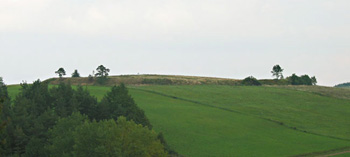The cultural heritage and history
The Cultural Heritage of the Magura National Park
A brief history of the area
Wandering around the Magura National Park (using of course only the tourist trails) we can meet numerous “souvenirs of the past”, both ancient and recent.
Stone tools from the Neolithic Age found in the Pielgrzymka village, numerous findings from Bronze and Iron Age from the area of upper Wisloka river and Roman coins found in Nowy Zmigrod can show that this region has been inhabited since ancient times.
The oldest trace of the early medieval castles (from the 7th c.) – Walik near Brzezowa and Zamczysko situated in the south of Nowy Zmigrod, are the evidence of the existence of the Wislanie country in this area.

Walik hill (phot. Slawomir Basista )
In the 10th and 11th century the first settlements were established by the Benedictine Order from Tyniec and the Cistercian Order from Koprzywnica. A great pace of the colonization took place under the reign of the Polish king Kazimierz Wielki. Then, in the valley of the Wisloka river, the towns Nowy Zmigrod, Osiek and Debowiec were founded and also numerous villages were founded according to the so-called Magdebury (German) Location Law and Polish Location Law.
The end of the 14th century and the 15th century were the times of great migrations. At that time, into the area of the Beskid Niski Mts., came the Balkan shepherds, the so-called Wolosi, the Russniaks coming from the Southern Carpatians along the Beskidy Mts. towards the west, the Hungarian people running away after the downfall of the peasants’ uprising and also some religious refugees from Slovakia. Numerous villages were founded according to the so-called Woloski Location Law as it was better for the mountain conditions farming.
Those intensive migrations caused the economic revival. The citizens were mainly engaged in craft and trade. The rural population, apart from pasturing, were in production of the wood tar, burning the charcoal and making shingles. There were also villages of an industrial character, where people were working in the glassworks industry. Nowadays only the names of the villages remained: Huta Polanska or Huta Krempska (huta – glassworks).
The economic development was being interrupted by the numerous invasions. In 1474 many villages fell victim to the armed Hungarian forces of the king Matthias Corvinus of Hungary. In 1655 the Swedish army reached these lands, and two years later a great devastation was caused by the troops of the Transylvanian prince George II Rakoczi.


